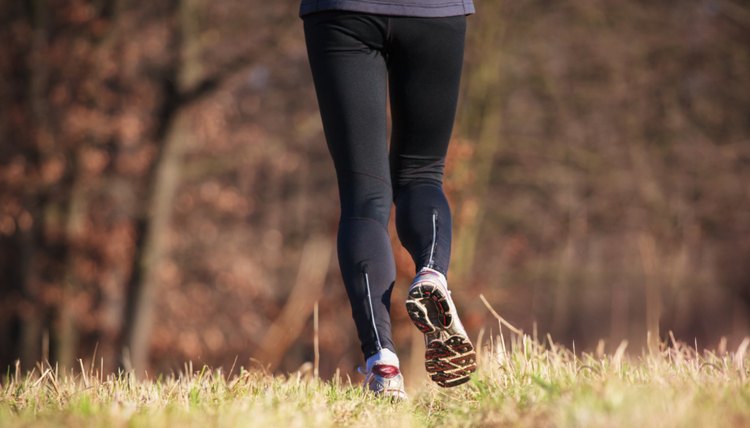Will Running Help Your Inner Thighs?

Envision your inner thighs as the shock absorbers and springs of a car. If your car has weak shocks and springs, it would bounce and zigzag through traffic. When you run, your inner thighs help to stabilize your hips so they’re not rocking or turning. They also keep your legs and feet pointing forward. You can add resistance, such as hill running, to boost the intensity of a running workout for your inner thighs.
Focus on the Swing Phase
The pulling action of your non-weight-bearing leg, your swing leg, is your main driving force while running, according to the The Osborne Running Analysis Lab. This determines your pace, cadence and acceleration. The muscles that control your swing leg are your inner thighs and hip flexors, and the best way to work them harder is to pick up the pace and run faster. If you’re shuffling through a run or jogging, you won’t effectively engage your inner thighs or hip flexors.
Hit the Hills
The most effective type of running for your inner thighs is hill repeats, which add resistance, boost intensity and lower the impact on your joints. Because running on an incline demands a greater thrust forward with your swing leg, it'll work your inner thighs. For example, identify a hill that is anywhere from 40 yards to a few hundred yards long. Begin with 10 to 15 minutes of light cardio and dynamic stretches, such as leg swings, arm circles, jumping jacks and squats. Sprint up the hill, shortening your stride and pushing off with the balls of your feet on each stride. Avoid leaning forward, keeping your posture upright. Perform five sprints at 75 percent of your maximum effort, walking downhill to return to starting position. Gradually add one to two more sprints per week until you can do 20 sprints per session at full speed.
Direct the Feet
Correct running form requires that your feet remain parallel and toes point in the direction of your forward trajectory. To keep your feet in this position, the inner thighs help to rotate the legs inward and toward the body’s midline. If you run with your feet splayed, you use your inner thighs less. Every foot strike requires that you twist your knee, which can stretch the connective tissue in your knee and lead to injury. Resistance exercises, such as side leg lifts, lateral leg swings with ankle weights, lateral step-ups or clam shells with elastic bands, can strengthen your adductors and prevent injury. Simple knee bends in which you flex your knees at a 45-degree angle can help to build your adductors. Focus on keeping your knees in line with your big toes to practice proper alignment for running.
Correct Imbalances
Running strengthens your hamstrings and calves faster than the other muscles in your legs, according to “Running” by Art Liberman, Stephen Pribut and Carlo DeVito. Because your quads, shins and inner thighs develop at a slower pace, they tend to be weaker. The resulting muscular imbalance can pull your kneecap out of alignment -- a condition many runners experience. Try cross training with other physical activities, such as cycling, to rectify this imbalance. Leg presses on a machine also help to build the inner thighs. When you do presses, lower the platform to the point at which your legs form a 30-degree angle instead of lowering it to the standard 90-degree angle. The less extreme angle will keep the stress on your quads and inner thighs and lower the pressure on your knees.
References
- Running for Mortals: A Commonsense Plan for Changing Your Life With Running; John Bingham, Jenny Hadfield
- Runner’s World Complete Book of Beginning Running; Amby Burfoot
- Chi Running: A Revolutionary Approach to Effortless, Injury-Free Running; Danny Dreyer, Katherine Dreyer
- Runner's World: the Complete Book of Women's Running: Get Started, Stay Motivated and Run with Confidence; Dagny Scott Barrios
- Runner’s World: Damage Control A Better Way to Stretch This Month: Iliotibial Band
- Breaking Muscle: Hill Sprints: How to Build Muscle and Burn Fat
- Boston Magazine: Six Adductor Exercises to Build Strength
Writer Bio
Kay Tang is a journalist who has been writing since 1990. She previously covered developments in theater for the "Dramatists Guild Quarterly." Tang graduated with a Bachelor of Arts in economics and political science from Yale University and completed a Master of Professional Studies in interactive telecommunications at New York University.
